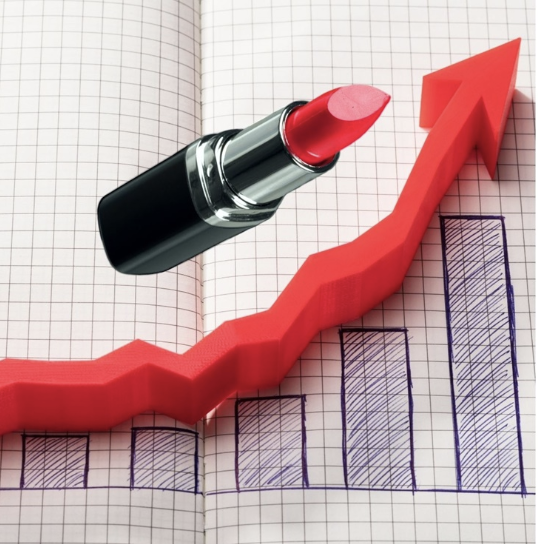Finance & Fashion: Does the Economy Influence Fashion Trends?
Written By: Jordann Landretti
The economy has a substantial impact on fashion trends, manifesting itself in the silhouettes, colors and, of course, prices of clothing. Many factors go into fashion trends, but the economy directly impacts costs, which can translate into how people dress. There have been theories about trends in the economy being linked to how modestly people dress, a debate that is finally losing its significance. A popular theory that fashion directly correlates with market trends is called The Hemline Index. It suggests that skirt lengths are linked to trends in the market and can predict the future of financial markers. The theory states that a prosperous and healthy financial market will correlate with short skirts, whereas long skirts signify poor economic health and an adverse financial market (Manfull, 2022).
The Hemline Index is a theory and not a proven fact, but historical fashion trends demonstrate why it is popular. The correlation was first noted in the 1920s when the economy was in a healthy place and growing. Fashions of flappers, shift dresses, and short skirts became popular with this economic growth and prosperity. Wearing flashy, expressive clothing was very trendy until the stock market crashed in 1929, which led to popular skirt lengths extending to calf length. In the 1930s, the Great Depression hit, which caused a major downfall in the economy and longer skirts and other modest fashions became trendy.
Due to the tragedy of Pearl Harbor in the 1940s, the United States drafted masses of men into WWII, leaving women to tend to the economy and its growth. Thus, skirt lengths were shortened for work purposes and the need to help the economy grow (Waligora, 2023).
In the 1960s, when the economy recovered after the war, the miniskirt had its moment, and more expressive short clothing became popular once again. Showing off legs was in, along with many job opportunities and higher wages, which made for a more young and fun environment. The 1970s dealt with inflation of oil prices and coping with yet another war, causing stock prices to fall, and thus once again skirt lengths fell to maxi and floor length fashions. Fashion in the '90s took a turn when the recession hit in 1990, with popular skirt lengths at midi and maxi featured in films and TV shows made at the time.
Now, looking at the early 2000s to 2025, it is harder to see correlations between fashion and the economy (Waligora, 2023). There are so many factors that go into what causes fashion trends, and while The Hemline Index seems to have merit, there are no actual studies that prove its validity. Many other social factors cause skirt lengths to change as demonstrated by various political and social climates. It is easy to give little examples of why this theory is true, but it is just a theory and one that no longer carries as much weight (Komar, 2020).
There is another major factor that influences fashion trends: social media. It is curated based on individual desires and styles, and features millions of trends. These trends have layers and subsections that make up different aesthetics and styles, which makes the link between a longer skirt length to a recession hard to prove. Attitudes towards feeling uncertain in changing social and political environments, as seen historically, can cause women especially to dress more modestly in response, but now it is more so for what an individual likes and chooses versus a widespread opinion.
The Hemline Index also gives a negative connotation with modest dressing and coverage, which is not a progressive way of viewing fashion.
A positive aspect of social media is that you can consume empowering content with the way you want to dress and find inspiration. Historically, you could not get fashion inspiration with the touch of a button, which is where more cohesive fashion trends, such as skirt length, could be traced and perceived as correlated with economic factors. The Hemline Index is not the only correlation that shows signs of where the economy is headed; the Lipstick Index shows that people favor small luxuries over large, expensive items in times of a poor economic environment.
The Lipstick Index was attributed to Estée Lauder’s Leonard Lauder, showing that consumers were driven to buy more affordable luxuries like nice lipstick rather than designer items. This became especially apparent in the crisis of 2008 with a major financial downfall. Luxury was dying, and fast fashion is ever-growing in popularity which continues to be the truth (Noonan, 2025). Influencers and social media play an interesting role in this, as buying little things such as makeup to feel like a popular celebrity and influencer is a trendy idea. A current trend that has taken off is quiet luxury, which is all about looking expensive without showing off designer logos. Hiding wealth may be a sign of a declining economy, which plays into dressing more modestly with muted colors and longer silhouettes (José Criales-Unzueta, 2025).
Regardless of the theory, fashion is heavily influenced by what is going on in the world from an economic, social and political standpoint. It is hard to pinpoint a recession causing skirts to get longer, but certain factors can contribute to more modest clothing trends and more revealing clothing trends. The Hemline Index is also based on United States History and does not account for fashion around the world. However, fashion is significantly linked to the costs and prices of fabrics, labor and the manufacturing of clothing, similar to what the Lipstick Index suggests. A recession means that people are less willing to spend more money on luxury clothing, which is why fast fashion continues to be popular and quiet luxury is taking the internet by storm.
While the Hemline Index may have at one point been a plausible theory, it no longer makes as much sense because there are too many factors that go into why people dress the way they do, and there are now more spaces for creativity to thrive. Not to mention, it only focused on women’s skirt lengths, which ignores that women wear more than just skirts and dresses. As well as that skirts and dresses aren't only worn by women. It will be interesting to see how future changes in the economy will impact what consumers are buying and their fashion choices, regardless of how long skirts will be.
Edited by Hana Razvi, Simran Khanuja, Giselle Franco, Quinn Diedrich & Olivia Ruetten
DEI Reviewed by Kabir Chawla






